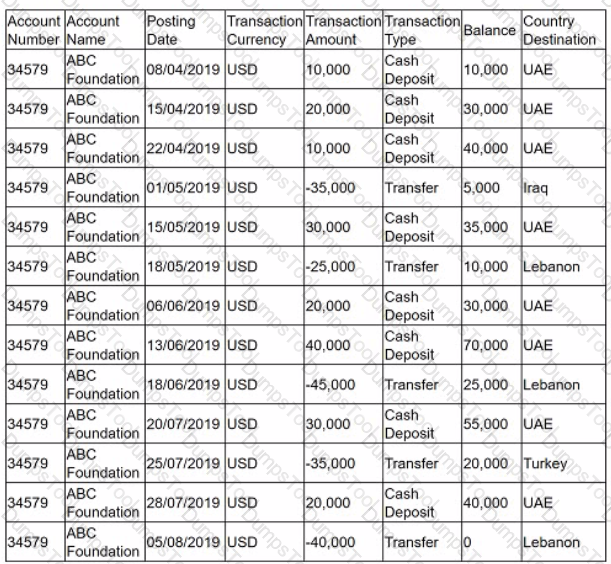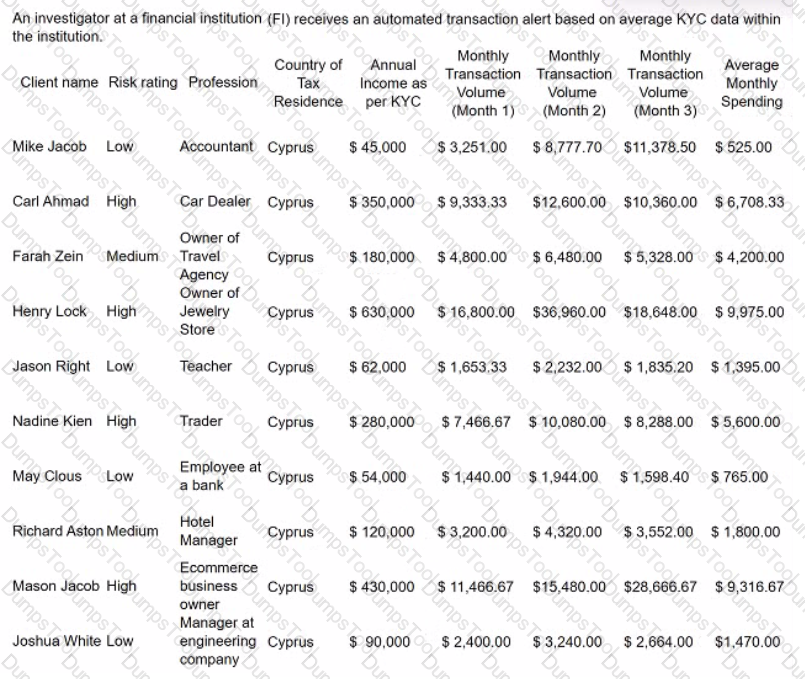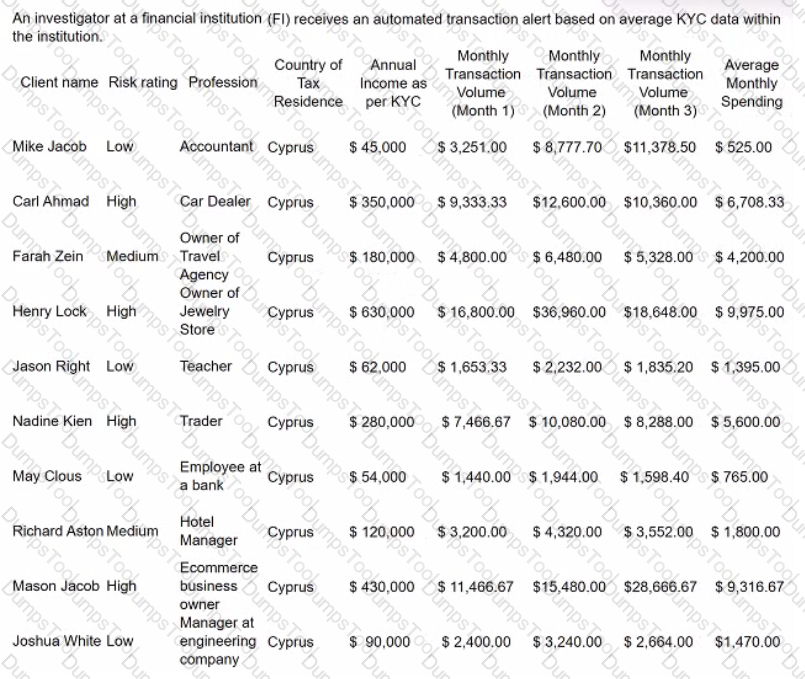A compliance officer of a financial institution is reviewing a payment for sanctions compliance between two parties in Europe and Asia. The payment is in Euros and involves the provision of services to a company located in a jurisdiction subject to Office of Foreign Assets Control secondary sanctions. Which factor is most important in determining the compliance officer's response?
The intended benefits of section 314(b) of the USA PATRIOT Act include: (Select Three.)
Sanctions screening requirements include that a financial institution should:
During transaction monitoring. Bank A learns that one of its customers. Med Supplies 123, is attempting to make a payment via wire totaling 382.500 USD to PPE Business LLC located in Mexico to purchase a large order of personal protective equipment. specifically surgical masks and face shields. Upon further verification. Bank A decides to escalate and refers the case to investigators.
Bank A notes that days prior to the above transaction, the same customer went to a Bank A location to wire 1,215,280 USD to Breath Well LTD located in Singapore. Breath Well was acting as an intermediary to purchase both 3-ply surgical masks and face shields from China. Bank A decided not to complete the transaction due to concerns with the involved supplier in China. Moreover, the customer is attempting to send a third wire in the amount of 350,000 USD for the purchase of these items, this time using a different vendor in China. The investigator must determine the next steps in the investigation and what actions, if any. should be taken against relevant parties.
The investigator is gathering more information to determine if a SAR/STR filing is needed. Which steps are the correct ways of collecting the additional information? (Select Two.)
Each month the automated transaction monitoring system generates alerts based on predetermined scenarios. An alert was generated in relation to the account activity of ABC Foundation. Below is the transaction history for ABC Foundation (dates are in DD/MM/YYYY format).

The relationship manager for ABC Foundation contacts the client to request more information on the beneficiary of the transfer in Turkey. ABC Foundation advises that this is a not-for-profit charity group called 'Forever Free." Which is the best next step in the investigation?
How does the Financial Action Task Force (FATF) measure the effectiveness of a country's efforts to combat money laundering and terrorist financing?
Due to an ever-diversifying business model and multi-jurisdictional footprint, a casino has decided to outsource the source of funds and wealth checks to a third-party provider. Why is it important for the casino to maintain control of the output from the provider?
Law enforcement (LE) suspects human trafficking to occur during a major sporting event. LE officers asked several financial institutions (FIs) to monitor financial transactions occurring before, during, and after the event.
An investigator identified a pattern linked to a business. The business' account received multiple even dollar deposits between midnight and 4:00 AM. They occurred each day for several days prior to the date of the sporting event. Also, large cash deposits, typically between 2,000 USD and 3,000 USD. made by a person to the business' account occurred in many branches in the days after the sports event.
There was little information about the company. The company did not have any history of employee payroll expenses or paying taxes. Expenses from the business account included air travel and hotel expenses. Searches about the person making cash deposits showed little. An online social media platform webpage with the individual's name showed ads for dates" and "companionship."
The Fl receives a keep open' letter from LE for the identified account and agrees to keep the account open. What is the Fl required to do?
Why is a more robust supervisory approach needed by regulators when overseeing small- and medium-sized money service businesses (MSBs) compared to larger MSBs for combatting terrorist financing (TF)?
The law enforcement agency (LEA) of a foreign jurisdiction contacts a financial institution (Fl) regarding one of the Fl's clients. The LEA advises that the client is currently wanted for prosecution as a result of a series of human trafficking charges. What should the Fl do? (Select Two.)

During a review of the accounts related to Richard Aston, an investigator notices a high number of incoming payments from various individuals. They also notice that these incoming payments typically occur during large sporting events or conferences. As a result of the account review, of which illegal activity does the investigator have reasonable grounds to suspect Richard Aston?
How does the Asian/Pacific Financial Action Task Force
A compliance analyst is reviewing the account activity of a customer that they suspect may be indicative of money laundering activity. Which is difficult to determine solely from the customer's account activity and KYC file?
Law enforcement (LE) suspects human trafficking to occur during a major sporting event LE officers asked several financial institutions (FIs) to monitor financial transactions occurring before, during, and after the event.
An investigator identified a pattern linked to a business. The business' account received multiple even dollar deposits between midnight and 4:00 AM. They occurred each day for several days prior to the date of the sporting event. Also, large cash deposits, typically between 2,000 USD and 3,000 USD. made by a person to the business' account occurred in many branches in the days after the sports event.
There was little information about the company. The company did not have any history of employee payroll expenses or paying taxes. Expenses from the business account included air travel and hotel expenses. Searches about the person making cash deposits showed little. An online social media platform webpage with the individual's name showed ads for dates1' and "companionship."
The Fl wants to create an automated alert for human trafficking money laundering after this investigation. Which activity type should they target?
A criminal is engaged in chain hopping while trying to launder ransomware payments. The criminal will likely:
The investigative department of a financial institution (Fl) receives an internal escalation notice from the remittance department for a SWIFT message requesting a refund due to potential fraud. The notice indicates that a total of three international incoming remittances were transferred to a corporate customer from Country A, in the amount of approximately 5 million EUR for each. The first two incoming remittances had been exchanged into currency B and transferred out to Country B a few days ago. The third incoming remittance has been held by the remittance department.
As noted from the KYC profile, the corporate customer is working in the wood industry. with the last account review completed 3 months ago. Since the account's opening. there has been no history of a large amount of funds flowing through the account. The investigator conducts an Internet search and finds that the remitter is a food beverage company.
The same morning, the investigator receives a call from a financial intelligence unit (FIU) inquiring about the same incident. The FIU states that it will issue a warrant to freeze the account on the same day.
After further review, the decision is made that transactions appear suspicious. Which are the next steps the investigator should take? (Select Two.)
A client that runs a non-profit organization that aids refugees in leaving their home countries received a remittance from a money services business that was ten times the average. The client was recently detained for providing falsified passports to illegal immigrants. Which predicate offenses could be considered in the SAR/STR? (Select Two.)
Which statement most accurately characterizes the methods used by transnational criminal organizations?
A financial regulator is evaluating the effectiveness of a financial institution's (Fl) anti-financial crime program. Which condition should be met to satisfy the regulator?
Which payment method for purchasing luxury items is a red flag for potential money laundering?
In a SAR/STR narrative concerning Individual A. which statement indicates a product of analysis rather than a fact or judgement?
An analyst reviews an alert for high volume Automated Clearing House (ACH) activity in an account. The analyst's initial research finds the account is for a commercial daycare account that receives high volumes of large government-funded ACH transactions to support the programs. The account activity consists of checks (cheques) made payable to individual names in varying dollar amounts. One check indicates rent to another business.
An Internet search finds that the daycare company owner has previous government-issued violations for safety and classroom size needs, such as not having enough chairs and tables per enrollee. These violations were issued to a different daycare name.
Simultaneous to this investigation, another analyst sends an email about negative news articles referencing local child/adult daycare companies misusing governmental grants. This prompts the financial institution (Fl) to search all businesses for names containing daycare' or 'care1. Text searches return a number of facilities as customers at the Fl and detects that three of these businesses have a similar transaction flow of high volume government ACH funding with little to no daycare expenses.
During the investigation, it was determined that some of the checks were issued to a mother-in-law of a PEP and deposited into her account with the Fl. This customer was not found on the Fl's PEP list How should the investigator proceed in this situation"? (Select Two.)
While each is potentially important, which allows an investigations analyst to better write a SAR/STR narrative that is useful to law enforcement? (Select Two.)
An investigator at a corporate bank is conducting transaction monitoring alerts clearance.
KYC profile background: An entity customer, doing business offshore in Hong Kong, established a banking business relationship with the bank since 2017 for deposit and loan purposes. It acts as an offshore investment holding company. The customer declared that the ongoing source of funds to this account comes from group-related companies.
• X is the UBO. and owns 97% shares of this entity customer;
• Y is is the authorized signatory of this entity customer. This entity customer was previously the subject of a SAR/STR.
KYC PROFILE
Customer Name: AAA International Company. Ltd
Customer ID: 123456
Account Opened: June 2017
Last KYC review date: 15 Nov 2020
Country and Year of Incorporation: The British Virgin Islands, May 2017
AML risk level: High
Account opening and purpose: Deposits, Loans and Trade Finance
Anticipated account activities: 1 to 5 transactions per year and around 1 million per
transaction amount
During the investigation, the investigator reviewed remittance transactions activities for the period from Jul 2019 to Sep 2021 and noted the following transactions pattern:
TRANSACTION JOURNAL
Review dates: from July 2019 to Sept 2021
For Hong Kong Dollars (HKD) currency:
Incoming transactions: 2 inward remittances of around 1.88 million HKD in total from
different third parties
Outgoing transactions: 24 outward remittances of around 9 4 million HKD in total to
different third parties
For United States Dollars (USD) currency:
Incoming transactions: 13 inward remittances of around 3.3 million USD in total from
different third parties
Outgoing transactions: 10 outward remittances of around 9.4 million USD in total to
different third parties.
RFI Information and Supporting documents:
According to the RFI reply received on 26 May 2021, the customer provided the bank
with the information below:
1) All incoming funds received in HKD & USD currencies were monies lent from non-customers of the bank. Copies of loan agreements had been provided as supporting documents. All of the loan agreements were in the same format and all the lenders are engaged in trading business.
2) Some loan agreements were signed among four parties, including among lenders. borrower (the bank's customer), guarantor, and guardian with supplemental agreements, which stated that the customer, as a borrower, who failed to repay the loan
After reviewing the transaction journal, request for information response, and supporting documentation, the investigator determines that additional information is needed. Which additional information should the investigator request?

In a review of the account activity associated with Nadine Kien, an investigator observes a large number of small- to medium-size deposits from numerous individuals from several different global regions. The money is then transferred to a numbered company. Which is the next best course of action for the investigator?